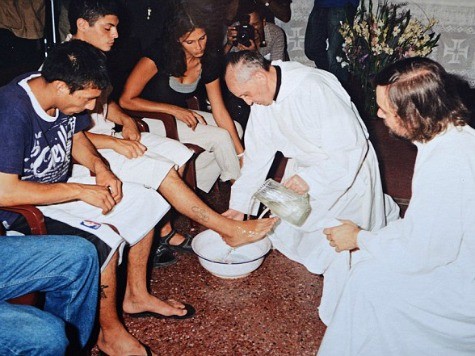On Sept. 7, Pope Francis declared a day of prayer and fasting to urge national leaders to come to a peaceful resolution of the conflict in Syria. The Supreme Pontiff of the Roman Catholic Church spoke passionately in his homily to those assembled in St. Peter’s Square at the Vatican of the cost of armed conflict, saying, “As if it were normal, we continue to sow destruction, pain, death! Violence and war lead only to death, they speak of death! Violence and war are the language of death!”
When he said these words, Francis was not only speaking in philosophical terms, he apparently was also drawing upon his own experience facing down a brutal military dictatorship in his home nation of Argentina between 1976 and 1983.
When Cardinal Jorge Mario Bergoglio was elected pope in March 13, 2013, rumors began to surface that he, while the provincial superior of the Jesuit order, had collaborated with the military junta that carried out a “Dirty War” against suspected Communists and subversives, which gruesomely murdered between 9,000 and 30,000 people. And the tales surfaced quickly.
A March 15, 2013, online piece from The New Yorker called “Pope Francis and the Dirty War”–which ran through a litany of anti-Catholic themes from history before settling on the new pope–said (without citing a specific source), “The key allegation against [Bergoglio] is that he pointed out left-leaning priests to the military as dissidents, leaving them exposed, and that he did not defend two kidnapped clerics or ask for their release. He has denied this, and says instead that he protected priests and others–just quietly, in secret.”
Journalist Nello Scavo, who covers legal and judicial affairs for the Italian Catholic daily Avvenire, also heard the rumors and decided he would try to find out what what Father Bergoglio actually did and didn’t do. Of course, if Scavo was able to support the allegations against the new pope, he would have an explosive story.
The result of his investigation is a 192-page book, due to hit Italian bookstores on Oct. 1 (or 3rd, depending on the source; excerpts were released Sept. 6) and currently available only in Italian, called La lista di Bergoglio salvata da Francesco durante la dittatura (or, in English, Bergoglio’s List: Those Saved by Pope Francis; Stories Never Told), put out by the missionary publishing house EMI. Translations are underway for future release in eight other countries.
It contains the personal stories of people–with names and faces–saved through the efforts of the future pontiff. An appendix features the transcript of the Nov. 8, 2010 testimony Father Bergoglio gave over the course of nearly four hours of interrogation in front of three judges regarding crimes committed in the Escuela de Mecanica de la Armada (ESMA), the Navy School of Mechanics, that operated during the dictatorship period.
These crimes included torture of the two “kidnapped clerics” mentioned by the New Yorker–Fathers Franz (or Francisco) Jalics and Orlando Yorio. The surviving priest, Jalics, made a public statement in March from his home in a German monastery, admitting that he once was led to believe that Bergoglio had denounced him, but added, “at the end of the ’90s, after numerous conversations, it became clear to me that this suspicion was unfounded. It is therefore wrong to assert that our capture took place at the initiative of Father Bergoglio.”
As outlined in detailed reviews of the book’s information put out by Catholic News Service (CNS), La Stampa’s Vatican Insider, and in an online post by Italian journalist Sandro Magister of the weekly L’Espresso magazine (who previously angered the Vatican by releasing salacious details about papal appointee Monsignor Battista Ricca), Father Bergoglio used a variety of means to shield or arrange safe passage for those under threat.
The list includes fellow Catholic priests and seminarians and such laypeople as a Uruguayan militant, a scholar who was saved without his knowledge at the time, a non-baptized woman who became a judge in Argentina, and married Christian missionaries working in a Buenos Aires slum.
The piece in the Vatican Insider credits Francis’s reticence and now-famous humility to explain why he has not defended himself more vigorously since becoming pope. It also cites the Gospel of Matthew (6:3-4), which quotes Jesus as warning against taking public credit for good works, saying, “But when you give alms, your left hand must not know what your right is doing; your almsgiving must be in secret, and your Father who sees all that is done in secret will reward you.”
Magister closes out his piece by saying, “As pope, but first as man, Francis does not cease to amaze.”
Pope Francis has also not ceased his calls for peace, speaking against all forms of religious violence and calling for prayers for Syria on Monday, Sept. 30 (as he did the previous day in the Angelus prayer recited at the end of Mass in St. Peter’s Square with teachers of the Faith, called catechists).
The appeal came on the same day as the announcement that April 27, 2014, known as Divine Mercy Sunday on the Catholic calendar, would also be the canonization day for Popes John XXIII and John Paul II.

COMMENTS
Please let us know if you're having issues with commenting.